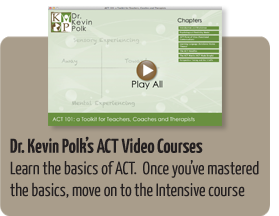19
2014
Healthcare Redesign: A bottom-up Approach
Posted by Kevin Polk /

I had the good fortune of sitting side by side with Jerry, who works as an industrial engineer, on a recent Delta flight from Orlando to Atlanta. He ask what I did and I replied that I have the pleasure of training people how to do psychological flexibility. He replied, “You must be a clinical psychologist. I really thought about studying psychology.” That lead to a flight-long discussion about the psychological flexibility matrix, psychological safety, Lean, Six Sigma and heath care redesign. (Jerry does Lean, Six Sigma, and healthcare redesign.)
We talked about “job one” when engaging people toward any system-change talk is to start with psychological flexibility. We also talked about increasing psychological safety, and then getting everyone talking within a bottom up change process. In such a process the healthcare providers (physicians, nurses, etc.) would generate most of the ideas for change, try them out, and then keep doing what works.
With a few notable exceptions (ThedaCare comes to mind) most of our current healthcare redesign is top-down with cost-cutting-efficiency “gurus” telling providers how to do more with less. The result has been burned out, angry providers who leave for better jobs, or worse, leave the profession.
Jerry and I talked about combining the Psychological Flexibility Matrix with Lean and Six Sigma to help with some of this healthcare redesign. We figure that through a bottom-up process healthcare providers, and not bean counters, will create some really cool solutions.
You just never know what cool next person life will throw you way. This time I got Jerry. Very cool.
Be well,
Kevin
14
2014
Thinking Fast and Slow: Matrix Style
Posted by Kevin Polk /

This Matrix is based on Daniel Kahneman’s book, Thinking Fast and Slow. The Fast (System 1) “Experiencing Self is twice as likely to respond “Away” than “Toward.” Fast System 1 responding is automatic and out of awareness. System 2 is more deliberate and mostly conscious. System 2 is who we talk (respond) to (self or others). The response we give is a combination of the output from Experiencing Self/System 1 and Remembering Self/System 2. System 1 and 2 are heuristic, and the combination even more. So, from this Kahneman point of view, we most often come up with workable responses, but there is also quite a bit of inherit “unworkable” and novel responding.
There are inherent biases (not to mention dogma) in both systems. I’m figuring that a discussion of these biases can be made part of the matrix process.
More to come….
5
2014
13 Points to Training the Matrix
Posted by Kevin Polk / Matrix Training

Several people have asked me, “How do I teach others about the matrix?” Below is the response I give now. I’ve included a “13-Point Matrix diagram.”
If you want to hear me run through these 13 points, join me for a webinar Wednesday, June 11, 2014. Click Here for more information.
Basic Matrix Training: 13 Points
I’m assuming you already have The ACT Matrix book. That’s a wealth of information. Have you watched the ACT 101 video series from my website? Go to www.drkevinpolk.com and look to the lower right and you will see “Dr. Polk’s Video Courses.” The ACT 101 series is free.
The way I teach the matrix these days is through 13 Steps
Preamble: “Hello, I’m ________ and I work from the Psychological Flexibility Point of View. Is it okay if I show you that point of view? Great!
1. Sensory Experiencing,
2. Mental Experiencing,
3. Noticing the Difference,




